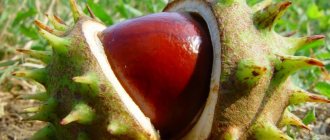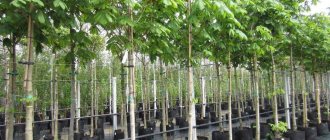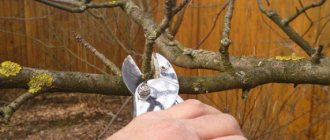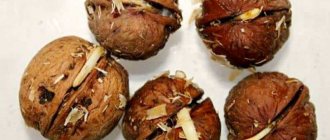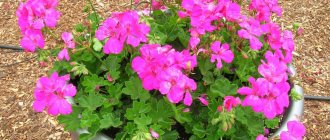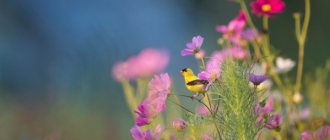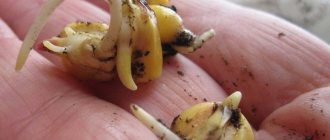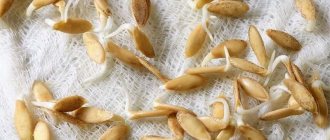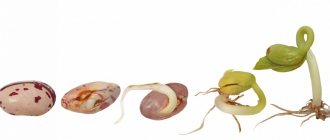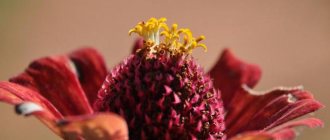As already mentioned in the article, the best storage methods are: freezing, storing in sand, canning.
- To preserve peeled chestnut nuts until spring, you can freeze or preserve them, but you cannot keep them in sand.
- If you want to preserve whole chestnut fruits for the winter, then you need to rinse, dry, cut and throw them into an airtight container. And put it in the refrigerator or freezer, depending on what period you do it. Because it will last longer in the freezer.
Is it possible to grow chestnuts at home?
To get your own chestnut alley, it is not at all necessary to purchase expensive seedlings. It is possible to grow trees from nuts.
More than 30 species of chestnut trees are known, but not all of them can be grown at home:
- Chestnut is a long-living tree. With proper care, the tree will live more than 500 years. The height of the chestnut reaches 35 meters, the leaves are large. Chestnut inflorescences are cream-colored and lush. The nuts are edible, large ones. The shell is soft.
- Chinese softest - the fruits have high taste qualities and are highly valued among gourmets. Tree up to 15 meters high, leaves are small and pubescent. Candles standing vertically, different colors.
- Japanese chestnut is distinguished by its growth rate. It begins to bear fruit in the third year of cultivation. The fruits are edible, weighing up to 100 g.
Chinese chestnut, the softest chestnut, seed chestnut, Japanese chestnut
When planting chestnut in the garden, keep in mind that it provides dense shade and its roots are located superficially. Absolutely nothing will grow under the tree , but no one forbids setting up a recreation area under its branches.
In addition, edible varieties of chestnuts need to be grown away from roads, plants and factories. A better solution is a country house. The fact is that the chestnut absorbs heavy metals and all toxic emissions; the fruits from the city tree are completely unsuitable for food.
Edible varieties of chestnuts need winter shelter, as they do not have high winter hardiness, unlike horse chestnut.
During the flowering period, chestnut trees are excellent honey plants . Honey has a slight bitterness, but is very healthy.
A little about the common chestnut
Horse chestnut (ordinary) is a powerful tall (up to 20-25 meters) tree with a spreading crown. Under favorable conditions, trees live for 100 years or more. What attracts people about chestnuts is, first of all, their decorative properties. This wonderful gigantic creation of nature decorates public gardens and parks at any time of the year. No one is left indifferent by the flower pyramids in May-June and the bristling hedgehogs of green nut shells in the summer. It is easy to find coolness under the crown of the chestnut tree on the hottest day, and at the time of leaf fall, children and adults enthusiastically collect fallen seeds.
A strong argument in favor of horse chestnut is its medicinal properties. Traditional medicine recipes involve all parts of the plant: flowers, bark, nuts, leaves. Powders, decoctions and ointments treat diseases of the skin, kidneys, joints, stomach and varicose veins. But, it should be remembered that the collection and procurement of medicinal raw materials is possible only in ecologically clean areas. One way out is to plant a chestnut tree yourself.
Which nut to choose for planting
To avoid mistakes in growing chestnuts, we advise you to listen to the opinion of experts and select only fallen nuts. They are used for further germination.
Freshly fallen chestnuts
The fruits should be smooth and beautiful in appearance, without damage or soft spots . Select hard chestnuts for planting.
If you plan to grow 1-2 trees, take about 5 nuts. Not all of them will germinate; some will die in the garden. You can always offer extra ones to your neighbors in the country.
It is better to start planting in the fall, after harvesting the fruits. It is not always possible to preserve nuts until spring without loss. They dry out and lose their viability . If this is not possible, then chestnuts should be stored in a bag of damp sand until spring.
Which ones to buy
Ripe fruits bring maximum benefit to the body. They are collected in September - February. At this time, they contain the maximum range of minerals and vitamins necessary for the human body. In this case, the choice should be limited to the following indicators:
- you should buy fruits with hard-to-touch shells;
- they must have a smooth, glossy surface;
- have a dark brown color;
- you should pay attention to products of approximately the same size;
- The round shape of the fruit has the most pronounced taste.
Simply pressing your finger on the surface of the chestnut can reveal its degree of freshness. If the peel turns out to be too soft, the fruit was stored under incorrect conditions and cannot be considered a quality product.
If the shell and kernel of the nut have a layer of greenish tint, this may be an indicator of insufficient ripeness. Before consumption, such chestnuts must be heat-treated (boiled, fried, stewed).
It is important to remember that eating unripe edible chestnuts can cause serious health problems.
The terms and conditions of storage of edible chestnut are mainly determined by the supplier company or manufacturer. Therefore, when purchasing fresh frozen or canned fruits, you should pay attention to their release date and expiration date. As a rule, the shelf life of chestnuts is 1 - 6 months.
Conditions for planting and growing chestnuts
The secret to successfully growing chestnuts is seed stratification. If you collect nuts in late autumn and plant them in open ground, then nature itself will do everything. But in indoor conditions you will have to stratify the seeds yourself.
To do this, immediately after harvesting, the nuts are placed in a container with sand and put in a cool place . This could be the refrigerator shelf or the basement. Experienced gardeners recommend burying a container of nuts in the garden under the snow. The nuts are stored there until spring. A week before landing they are taken out.
Before planting chestnuts, they must be soaked in water.
It is better to start planting nuts at the end of February or beginning of March . Before sowing, they are soaked in water for five days. The water is changed regularly to prevent it from spoiling. The shell of the nuts should soften well. This process activates the embryo and helps the sprout grow faster. The nuts are planted when a white sprout appears.
Almost any soil is suitable for germinating chestnuts. Nuts are planted immediately in separate containers with a volume of 300-500 ml . The substrate is well moistened and the seed is placed in it to a depth of 3-5 cm. The first shoots appear in 15-20 days.
Planting too deeply will result in the sprout not coming out. The high seating position helps the nut dry out. Follow the recommended depth.
Spring planting of chestnuts at home is preferable:
- The seedlings grow quickly and are quite strong by winter.
- tolerate winter well .
- The germination percentage is higher.
This method of growing chestnuts is less labor-intensive.
Collection and preparation of seeds
Nuts that fall from the tree on their own in the fall are considered suitable for planting. Fruits picked with hard skins may be unripe and such seeds will not be stored.
A prerequisite for germination is stratification. There are several options here:
- Store the seeds in a container with sand in a cool place (basement, bottom shelf of the refrigerator, etc.)
- Bury a mold with fruits in a personal plot under the snow
- Collect chestnuts in early spring under the parent tree.
Planting is preceded by soaking the seeds in warm water. The procedure lasts from 2-3 to 5-7 days with regular water changes. You can keep chestnut fruits in damp gauze. The nuts should swell. When a white sprout emerges through the softened peel, you should promptly plant the seed in the soil.
I don’t have much time for stratification and cannot create good wintering conditions for the chestnuts. This year I was collecting nuts under a large tree in the park when the snow melted. In the hope that planting through seedlings at home will give greater germination efficiency. Last year, I planted the autumn crop of nuts before winter at my summer cottage. Of the 10 pieces, 4 sprouted. 3 plants survived the second winter safely.
The only, but very significant, disadvantage of the spring harvest is to miss the moment. In hot weather, the spring chestnut sprout dries out very quickly. In some places, municipal services work effectively, raking out all the foliage with the nuts hidden in it in the fall. Therefore, the risk of being left without planting material is very high.
When to transplant seedlings into open ground
Young seedlings are transplanted into open ground after the threat of night frosts has passed. As a rule, this is the end of May.
When planting in the garden, keep in mind that chestnuts are large trees. The distance between seedlings must be at least 3 meters . Only under this condition the tree will delight you with a thick crown, beautiful and long-lasting flowering and tasty fruits. Any soil is suitable for planting, but black soil is best.
Set aside a bright place for planting, but so that the seedlings are not exposed to direct sunlight.
The planting hole must correspond to the root system of the seedling. The soil from the hole is mixed with humus and sand in a ratio of 2:1:1 and 500 grams of slaked lime are added . Phosphorus-potassium fertilizers are added little by little to each hole. The bottom of the holes is well drained with pebbles, crushed stone or sand. The height of the drainage layer is 10 cm.
Planting Chestnut seedlings in open ground
Planting of seedlings is carried out carefully, trying not to damage the tap root of the plant:
- Pour the prepared soil into the hole and moisten it well.
- The seedling is installed and sprinkled with soil.
- Compact the soil and water the chestnut tree.
For better rooting of young chestnuts, cover the plant with a paper bag for several days .
Caring for chestnuts in the garden in spring and autumn
Growing a chestnut tree from a walnut yourself is not as difficult as it seems. The main thing is to properly care for it and protect the young seedling from winds and animals.
The young chestnut tree is fenced with pegs and tied with a red ribbon . During the windy season, the plant is tied to a support so as not to damage the fragile trunk.
The walnut chestnut grows slowly, so you need to have a lot of patience. In the second year of cultivation, the tree will add only 20-25 cm . But already in the fifth year, with good care, it can grow up to 1.5 meters . The formation of a lush crown begins in the tenth year of life. Pruning will help stimulate crown formation.
Difficulties in growing
Even with good care, chestnut trees are subject to attack by pests and diseases. This greatly complicates growing the tree and can ruin all the work done.
Plants are most often affected:
- wood mite;
- chestnut moth;
- powdery mildew.
Chestnut leaf miner Powdery mildew on chestnut
As a preventative measure, the tree is sprayed with disinfectants twice a month.
It is not difficult to recognize powdery mildew on a chestnut tree . It manifests itself as characteristic dark or white spots on the leaves. Phosphorus fertilizers will help significantly reduce the risk of infection.
For pests, drugs are used that are less toxic and do not harm bees.
Chestnut trees with edible fruits deserve attention. They are not only beautiful, but also useful. With good care, seedlings will begin to bear fruit in the 7-8th year of planting . To avoid mistakes when planting walnut chestnut trees, carefully follow the instructions and advice of experienced gardeners. Remember that chestnuts require special care when they are young.
Horse chestnut can be a decoration for any garden plot. It is believed that this tree can bring good luck and improves energy. You can even grow chestnuts from walnuts in a pot at home in the fall. This does not require special expenses or the purchase of special equipment.
Diseases and pests
Growing chestnuts is greatly complicated by diseases and pests. Threats are present even in cases where the gardener takes care of his charges in good faith. The main thing is not to get lost when you discover a problem, but to take competent measures to eliminate it. First you need to know what pests and diseases can affect a chestnut tree.
Table: problems that chestnut may be susceptible to
| Problem | Which species are susceptible? | Symptoms | Control and prevention |
| Wood mite | Fruit, decorative | Leaves affected by mites turn red, dry out and become crumpled. Then they die off. | For prevention, the tree is treated once every 2 weeks with phytover (10–15 ml per 10 l of water) or karbofos (75–90 g per 10 l of water). In advanced cases, plants die. |
| Chestnut moth | Mostly decorative, less fruit-bearing | The insect infects the leaves, after which they fall off in the summer. By autumn, the tree arrives weakened and may not survive the winter period and die. | The fight is effective if you spray the affected areas with Lufox 105-EC. The concentration depends on the age of the plant; this information can be found on the packaging of the product. It destroys both larvae and adults. |
| Powdery mildew | Fruit, less ornamental | Fungal disease. White, grayish or dark spots appear on the leaves. Sometimes with a hint of “rust”. The leaves dry out, turn yellow or black, and fall off. | Prevention: inclusion of phosphorus fertilizers in the tree’s diet, treatment of plants with fungicidal compounds. |
| Hole spot | Fruit, less ornamental | Occurs due to fungal cultures. Many small holes appear on the leaves, the greenery darkens, the leaves die. | The remedy is Bords liquid with a strength of 1–3%. 10 days after the start of flowering, the plant is sprayed every 2-3 days until the signs of the disease disappear. |
Do not use toxic drugs that can harm pollinating bees. Otherwise, the tree will not bear the expected fruits. Regarding chestnut fruit species, toxins are dangerous in any case, because ripe nuts should be safe for humans. Damaged fallen leaves must be burned.
Photo gallery: chestnut pests and diseases
Growing chestnut trees requires a lot of effort. But all of them are more than rewarded if you properly care for the plant. Being in favorable conditions, seedlings of decorative chestnuts will delight you with a stylish exterior, and fruit species will delight you with delicious nuts rich in nutrients.
How to plant chestnut trees correctly
When planting chestnut seeds in open ground, they are not always able to survive the winter. To grow walnut chestnuts at home in the fall, seedlings can be grown in an apartment.
To grow horse chestnut from a nut at home, the seeds are collected in the fall and covered with sand moistened with water. Store them in a tied bag or a special container in a cool, dry place. Such a place could be a basement, balcony or veranda.
The storage period for nuts lasts until January-February. If you have to keep nuts in the room, they must be placed in the refrigerator. Please note: chestnut fruits should not be placed in the freezer under any circumstances.
Soil or sand for storing fruits is subjected to heat treatment for disinfection purposes. It is best to use an oven for these purposes, with which you can get rid of bacteria, fungi and other harmful microorganisms. Disinfection is a must, especially for sand. It is a breeding ground for many pathogenic microorganisms. It is better to take care of heat treatment in advance. After it is carried out, the soil will need time to restore its beneficial properties, the main one of which is fertility.
You need to plant nuts with soft skins in the soil. If sprouts do not appear by the end of winter, the nuts are filled with heated water before planting. You can add a little potassium permanganate to the liquid. The water is changed once a day, and the nuts are kept in it for 5–7 days. After the peel has softened, the nuts are covered with sand, controlling its moisture content.
The first shoots appear within 1.5-2 weeks. After their appearance, the chestnut should be transplanted into separate containers. Young plants will continue to grow in them.
Cold storage
Storing edible chestnuts in winter often ends in failure due to the formation of mold on the surface.
So how many and where can you store edible chestnuts? Due to the high moisture content in them, they should be sent to the refrigerator as quickly as possible and kept there until consumed.
The optimal storage temperature for chestnuts is from -1°C to 0°C. It does not matter whether the fruits are peeled or not. It is best to place the product as close as possible to the freezer (this is a different place for each type of refrigerator).
The products are placed in a polyethylene bag, in which holes are pre-made for air access. If the fruits are not ventilated, very soon they will begin to become moldy and become unfit for consumption.
The shelf life of chestnuts in the refrigerator is about 2 months.
After cleaning and roasting the nuts, they are kept on the refrigerator shelf for only a few days. If you need to keep the fried delicacies a little longer, then they should be sent to the freezer.
What you need to know to select planting material
In order to properly grow walnut chestnuts at home, special attention should be paid to the characteristics of the planting material. It is better to choose a tree with a strong and massive trunk. Nuts intended for planting should not be picked, but those that fall to the ground on their own should be taken. This can be explained by the fact that the nuts come off the tree when they are fully ripe. It is best to grow new chestnuts from such fruits.
Nuts do not germinate well, so it is recommended to harvest as many of them as possible. To grow 2-3 seedlings, you will need to plant at least 10 nuts.
Choose chestnuts for growing with intact shells without cracks, with a glossy surface, painted in dark brown shades. Such nuts are not affected by diseases inherent in the crop.
In order to grow an edible chestnut from a nut at home, the seed material needs to be prepared. The process of preparing for cultivation is called stratification. When stratifying, nuts are placed in a humid environment at low temperatures for 2–5 weeks. After its completion, when the seed material enters warm soil, it begins to actively germinate. Without this procedure, there are often cases when the fruits begin to rot after planting and do not sprout.
Chestnuts from nuts begin to be grown either in spring or autumn.
Frost protection
Chestnut is a moisture-loving and heat-loving tree. Although chestnut is frost-resistant, young trees need to be protected from frost. To do this, fallen leaves are placed under the tree, and the trunk is wrapped in several layers of burlap. This needs to be done every winter until the tree is completely strong.
Chestnuts are very beneficial for humans. Some varieties bear edible nuts that are used for cooking . Whether it is possible to grow a chestnut at home from a nut and how to plant it will be discussed further.
Planting chestnut
To grow a walnut chestnut in a pot at home, you need to do the following:
- Loose soil is poured into pots and nuts are planted in it. Choose pots with a capacity of 300–500 ml. The composition of the soil can be anything. A regular soil mixture from a specialty store will do, but it’s better to prepare the soil for planting yourself. To do this, the soil is mixed with humus in equal proportions. If desired, you can add dolomite flour to the pots;
- The planting depth should be no more than 3–5 cm. When planting nuts entirely, do not cover them with soil, so as not to slow down the germination process. If the plant is not immersed deep enough in the soil, the sprouts may dry out. Expanded clay is placed at the bottom of the pot to create a drainage layer;
- the soil is loosened and its moisture is controlled. When the soil dries out, it is watered;
- the first shoots appear after 2–3 weeks;
- seedlings are transferred to a permanent growing location in mid- or late spring.
Sowing seedlings in pots
I placed the hatched nuts in prepared pots with moistened soil. I had very little soil available, and I shouldn’t delay planting. That's why the cups are tiny. Ideally, 0.5 liter containers would be suitable. This is important: we place the nuts with the sprout at the bottom.
The planting must not be deepened. I sprinkle the chestnuts with a small amount of soil, water them and place them on the windowsill. It is recommended to trim the tip of the sprout with a sharp blade, followed by disinfection of the cut. I myself have not performed such an operation, since I do not find it particularly necessary. All further care consists of timely watering. If you flood the planting, the seed will rot. If there is a lack of moisture, it will dry out. In another week, a powerful sprout will appear (to match a nut).
Read also: Tarragon and tarragon difference
Do not rush to throw away the planting if you do not see an escape after 2-3 weeks. Personally, for me, one nut sprouted in a month. Of the 20 chestnuts I planted, 16 grew. Seedlings require a lot of light.
You can start hardening off the plants a couple of weeks before planting them on the site, taking them out onto an open balcony. First year chestnuts should be planted in an improvised nursery. It will become a corner of the garden, protected from wind blowers and the scorching sun. Plant two-year-olds in a permanent location next spring.
Care measures
After the sprouts appear, the chestnut nuts are transplanted into pots. They should remain indoors throughout the cold season. All this time, the seedlings need care.
To grow horse chestnut from a nut at home in the fall, you need to water it often. When there is a lack of moisture, plants stop growing. Chestnut is a water-loving crop, so it grows along river banks. Fertilizing will also be useful. The degree of soil moisture should be moderate.
The soil should not be allowed to dry out or be over-flooded. Stagnant moisture in the soil can cause root rot. After each watering, the soil must be loosened. This allows oxygen to reach the root system in the right amount.
When cultivating indoors, the air temperature should not fall below 20 ⁰C. With the onset of winter it should be lowered to 14–18 ⁰С. For wintering, chestnut prefers cool places.
It is better to replant plants once a year, after the leaves have completely fallen off.
Chestnut loves shade, so indoors it needs protection from direct sunlight. The sun can cause severe burns to the leaves. If there is insufficient lighting, the foliage will lose color. Choose neutral lighting that plants like.
Indoors, it is better to place pots with chestnuts on the east or west side. After the seedlings hatch their first leaves, they need fertilizing with fertilizers and loosening the soil around them.
Fertilizers are applied to the soil twice a year. At the beginning of the growing season, manure or urea is used in the form of a solution. Urea is diluted with water at the rate of 15 g per 10 liters. In autumn, chestnuts are watered with nitroammophoska dissolved in water, 15 g per 10 liters.
After the onset of spring, the seedlings can be transplanted into open ground. It is best to choose a cloudy day for this. Plants should be accustomed to new climatic conditions gradually. To do this, they are periodically taken outside. The residence time gradually increases.
Freezing
How to preserve chestnuts for the New Year's table? Very simple: freeze. But first they will need to be washed well, dried and peeled. Next, place in vacuum containers or wrap in foil. It is not advisable to store edible chestnuts in plastic packaging unless they have been roasted.
The shelf life of edible chestnuts in the freezer is 6 months.
Everyone can choose one or another storage method for themselves. It is important not to neglect the basic rules for saving this product so that its use does not cause concern.
Chestnuts are very beneficial for humans. Some varieties bear edible nuts that are used for cooking . Whether it is possible to grow a chestnut at home from a nut and how to plant it will be discussed further.
How to deal with plant enemies
Chestnut has increased immunity and almost does not suffer from diseases and pests. However, he may suffer from some of them:
- powdery mildew. It appears in the form of a white coating on the leaves. Gradually the foliage begins to turn black and fall off. Fitosporin, Fundazol and similar drugs are used for treatment;
- brown or red spotting. It causes black spots to appear, the number of which is constantly increasing. Leaves and branches affected by the disease are cut off and burned;
- chestnut moth. The best method of control is injection of systemic insecticides into the trunk. Choose long-acting medications. Additionally, you can use hormonal agents such as Insegar. This drug lasts a long time in the leaves.
Bonus
1. Nuts should be stored in a cool place before planting. To speed up germination, they are dipped in water.
2. For planting, choose nuts that have fallen to the ground, without cracks and in double quantities.
3. If you grow nuts indoors, plant them shallowly. The soil can be anything.
4. Plants are watered, loosened and fed with fertilizers.
5. Seedlings need protection from direct sunlight.
6. Young shoots must be treated against pests.
Author of the material Marina Kpevtsova
Cook and Fruit and Vegetable Grower 3rd class
Rate the author of the material. The article has already been rated by 1 person.
Chestnut is a tree-like ornamental plant from the Beech family native to Asia Minor. It has a spreading, dense crown and is often a decoration of city squares and parks. Chestnut has spread far beyond its natural habitat. This tall-growing tree comes in two types: with nuts that can be eaten, and horse chestnut, the fruits of which are inedible.
You can grow a plant in different ways. One of the most accessible is growing from nuts. The result obtained depends on the quality of the planting material, its preparation and planting, as well as on subsequent care of the tree.
Description of the plant
Chestnut is considered one of the most ancient plants. It is a deciduous tree that retains its ability to germinate throughout its entire life cycle. Various species are found wild in temperate and subtropical climates. There they can reach a height of up to 40 m. Chestnuts prefer limestone soils that are moderately moist. The fruits are spherical, nut-shaped, have a dense shell, and dark chocolate color.
Not all types of crops are suitable for home cultivation. More often you can find the following types of chestnut:
How to choose a nut for planting
Nuts for planting can only be taken from the ground. If they are still on the tree, they are still growing and are not yet ripe. Therefore, it is impossible to grow chestnuts from them. The best time to collect nuts is September or October (depending on specific climatic conditions).
Carefully inspect the surface of the planting material. It should be smooth, without cracks or other damage. It should not feel soft. It is better to collect chestnuts under trees with a massive trunk. Take the number of nuts several times more than necessary, since not all of them will germinate (on average, 1-2 trees grow out of 5 pieces).
Pre-landing preparation
Nuts are subject to certain preparation before they are planted in the ground. Since planting should take place in the spring, chestnuts must be stored properly until this time. They are immersed in bags of wet sand (previously disinfected) and placed in a cool room. This could be a basement, cellar, refrigerator. They will be stored there for several months. This stratification stimulates germination and improves the germination of nuts.
Moisten the sand from time to time to prevent it from drying out. Instead of sand, you can use a mixture of vegetable humus, forest soil with the addition of dolomite flour.
Before planting, it is necessary to soften the hard shell. Nuts are immersed in warm water. They are kept in it for about a week. The water needs to be changed once a day to prevent the chestnuts from turning sour. If white sprouts appear, the nuts are ready to plant.
How to plant
The best time for planting is the end of winter - the beginning of spring. In rare cases, autumn planting is practiced. The nuts do not have time to dry out and do not require long-term storage in the sand. But to guarantee germination, chestnuts still need to undergo stratification.
Requirements for pot and soil
The first container for chestnut is taken with a volume of up to 0.5 liters. You can plant several nuts at once, then it is better to take a planting container of sufficient volume, and then plant the seedlings in separate pots. There must be holes at the bottom for drainage. The plant has no special soil requirements. You can buy a ready-made universal soil mixture for garden crops. At the time of planting, it should be well moistened.
Landing rules
Place a drainage layer of expanded clay or broken brick at the bottom of the planting pot. 2 weeks before planting, the nuts need to be transferred from a cool room to a warm one, softening the shell. Chestnuts without sprouts are discarded. Plant suitable planting material into the soil to a depth of 5 cm. Shoots will appear in approximately 3 weeks. In order for the air to feed the nuts unhindered, it is necessary to regularly loosen the soil and water it moderately.
Planting walnut chestnuts in open ground
If you plan to further grow chestnuts on the site, you can first germinate a seedling in a pot and plant it, or you can plant nuts directly. It is preferable to do this in the fall. During the winter, the seeds will undergo natural stratification and produce better seedlings.
5 days before planting, soak the nuts in warm water. Make holes 10-15 cm deep at a distance of 20 cm from each other. Plant nuts in them and make a cover of dry leaves on top. To protect against rodents, additionally cover the planting with a chain-link mesh. In the spring, when shoots appear, leave only strong specimens. Weak growth is removed.
Transplant young seedlings to a permanent place a month before the onset of frost. Pits measuring 50x50 cm are prepared for them. A nutritious mixture of turf, sand, compost, and ash is poured into them. A peg is driven in nearby to tie up the seedling. Plants are deepened into the soil so that the root collar remains on the surface. The soil around the tree is mulched with peat.
How to care
Regardless of whether chestnut will be grown outdoors or indoors, it must be provided with appropriate conditions for development. The advantage of wood is that it is easy to care for. But it will grow faster and look better with enough light, heat and moisture. From a chestnut nut, in a year it can grow up to 0.25 m, and after 5 years it will grow up to 1.5 m.
Location
The plant should be placed in a well-lit place, but without direct sun. It is better to display the tree in the room on the east or west side. If the seedling is planted outside, then there should be no other plantings within a range of 3 m. Over time, the chestnut will suppress their growth.
Temperature
Young chestnuts growing in a pot must be protected from hypothermia. The optimal temperature for the plant is +17..26 degrees. Place the tree away from drafts. Once the leaves have fallen, the chestnut tree can be kept in cooler conditions. Do not overcool the roots.
Watering and humidity
It is very important to ensure proper watering in the first year of the chestnut’s life. Mature trees need less moisture. The soil should always remain moderately moist. Do not overdry the earthen ball. But it is also not recommended to prevent stagnation of water, so that the roots do not begin to rot. After each watering, loosen the soil, providing the root system with oxygen.
Top dressing
Fertilize the chestnut tree 2 times a year. At the beginning of the growing season, a solution of cow dung and urea is added. In autumn, water the plant with a solution of nitroammophoska. The tree needs feeding for the first 10 years. After that, it grows normally without them.
Trimming
Young chestnuts grow quite slowly. Therefore, they are not pruned for the first 3 years. After this age, the crown begins to form. In spring, trim ¼ of the trunk length. Lightly trim the side shoots. Follow this pattern regularly once a year. From 10 years old, the tree crown requires less attention. It is recommended to carry out only sanitary pruning of dry and weak branches and trim them. Treat the cut areas with garden varnish. If desired, you can form a bonsai from the chestnut tree. Only a dwarf tree variety is suitable for this.
From small to great
Chestnuts do not grow very quickly. A tree is considered sufficiently “mature” at the age of 8-10 years. I can’t say that I’m greatly burdened by worries about seedlings, but I shouldn’t leave the planting of the first 5 years unattended:
- Very elongated trees (not all) need additional support; I tie them to pegs.
- Regular watering is required (especially in dry weather).
- It is necessary to loosen the tree trunk circle and remove raging weeds.
- Young trees are responsive to fertilizing. I limit myself to a handful of azofoska in the tree trunk circle in the spring, and there are no particular problems with growth and development.
In the conditions of the middle zone, plantings of young chestnuts winter well without any additional shelter.
Horse chestnut is a very unpretentious tree that is easily propagated by seeds. It is not demanding on soils and does not require special care. It grows and makes you happy.
As already mentioned in the article, the best storage methods are: freezing, storing in sand, canning.
- To preserve peeled chestnut nuts until spring, you can freeze or preserve them, but you cannot keep them in sand.
- If you want to preserve whole chestnut fruits for the winter, then you need to rinse, dry, cut and throw them into an airtight container. And put it in the refrigerator or freezer, depending on what period you do it. Because it will last longer in the freezer.


